SandForce TRIM Issue & Corsair Force Series GS (240GB) Review
by Kristian Vättö on November 22, 2012 1:00 PM ESTAnandTech Storage Bench 2011
Last year we introduced our AnandTech Storage Bench, a suite of benchmarks that took traces of real OS/application usage and played them back in a repeatable manner. Anand assembled the traces out of frustration with the majority of what we have today in terms of SSD benchmarks.
Although the AnandTech Storage Bench tests did a good job of characterizing SSD performance, they weren't stressful enough. All of the tests performed less than 10GB of reads/writes and typically involved only 4GB of writes specifically. That's not even enough exceed the spare area on most SSDs. Most canned SSD benchmarks don't even come close to writing a single gigabyte of data, but that doesn't mean that simply writing 4GB is acceptable.
Originally we kept the benchmarks short enough that they wouldn't be a burden to run (~30 minutes) but long enough that they were representative of what a power user might do with their system. Later, however, we created what we refer to as the Mother of All SSD Benchmarks (MOASB). Rather than only writing 4GB of data to the drive, this benchmark writes 106.32GB. This represents the load you'd put on a drive after nearly two weeks of constant usage. And it takes a long time to run.
1) The MOASB, officially called AnandTech Storage Bench 2011—Heavy Workload, mainly focuses on the times when your I/O activity is the highest. There is a lot of downloading and application installing that happens during the course of this test. Our thinking was that it's during application installs, file copies, downloading, and multitasking with all of this that you can really notice performance differences between drives.
2) We tried to cover as many bases as possible with the software incorporated into this test. There's a lot of photo editing in Photoshop, HTML editing in Dreamweaver, web browsing, game playing/level loading (Starcraft II and WoW are both a part of the test), as well as general use stuff (application installing, virus scanning). We included a large amount of email downloading, document creation, and editing as well. To top it all off we even use Visual Studio 2008 to build Chromium during the test.
The test has 2,168,893 read operations and 1,783,447 write operations. The IO breakdown is as follows:
| AnandTech Storage Bench 2011—Heavy Workload IO Breakdown | ||||
| IO Size | % of Total | |||
| 4KB | 28% | |||
| 16KB | 10% | |||
| 32KB | 10% | |||
| 64KB | 4% | |||
Only 42% of all operations are sequential; the rest ranges from pseudo to fully random (with most falling in the pseudo-random category). Average queue depth is 4.625 IOs, with 59% of operations taking place in an IO queue of 1.
Many of you have asked for a better way to really characterize performance. Simply looking at IOPS doesn't really say much. As a result we're going to be presenting Storage Bench 2011 data in a slightly different way. We'll have performance represented as Average MB/s, with higher numbers being better. At the same time we'll be reporting how long the SSD was busy while running this test. These disk busy graphs will show you exactly how much time was shaved off by using a faster drive vs. a slower one during the course of this test. Finally, we will also break out performance into reads, writes, and combined. The reason we do this is to help balance out the fact that this test is unusually write intensive, which can often hide the benefits of a drive with good read performance.
There's also a new light workload for 2011. This is a far more reasonable, typical every day use case benchmark. It has lots of web browsing, photo editing (but with a greater focus on photo consumption), video playback, as well as some application installs and gaming. This test isn't nearly as write intensive as the MOASB but it's still multiple times more write intensive than what we were running last year.
We don't believe that these two benchmarks alone are enough to characterize the performance of a drive, but hopefully along with the rest of our tests they will help provide a better idea. The testbed for Storage Bench 2011 has changed as well. We're now using a Sandy Bridge platform with full 6Gbps support for these tests.
AnandTech Storage Bench 2011—Heavy Workload

The anomalies in random write performance definitely show up in our Heavy storage suite as well. As the two graphs below show, read performance is completely normal but write speed is slower than usual.
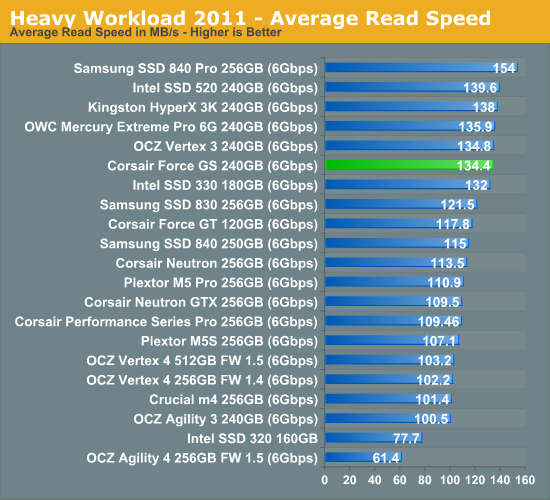
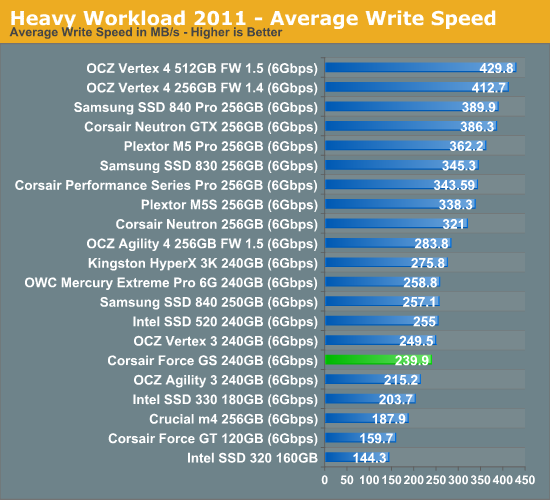
The next three charts just represent the same data, but in a different manner. Instead of looking at average data rate, we're looking at how long the disk was busy for during this entire test. Note that disk busy time excludes any and all idles; this is just how long the SSD was busy doing something:
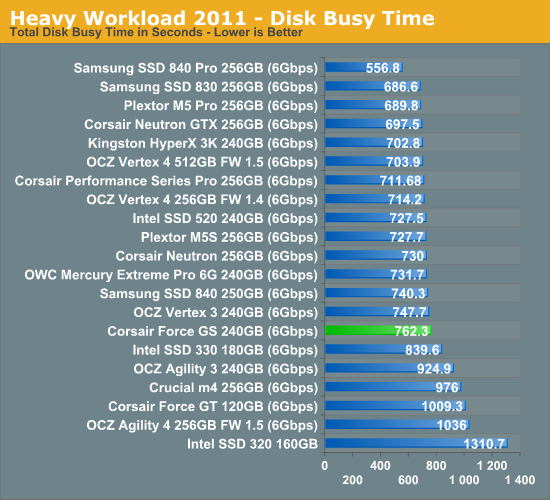
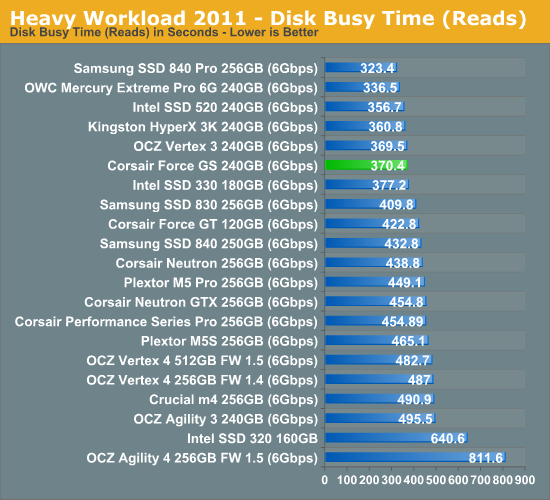
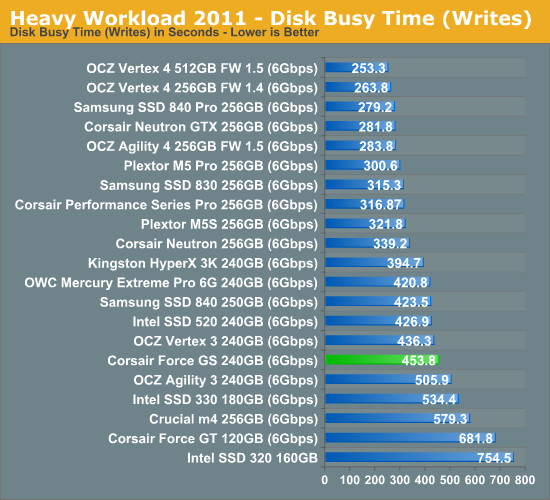










56 Comments
View All Comments
Kristian Vättö - Friday, November 23, 2012 - link
That is correct, Storage bench tests are run on a drive without a partition.Running tests on a drive with a partition vs without a partition is something I've discussed with other storage editors quite a bit and there isn't really an optimal way to test things. We prefer to test without a partition because that is the only way we can ensure that the OS doesn't cause any additional anomalies but that means the drive may behave slightly differently with a file system than what you see in our tests.
JellyRoll - Friday, November 23, 2012 - link
Well personally I think that testing devices that are designed to operate in a certain environment is important. You are testing SSDs that are designed for a filesystem and TRIM, without a filesystem and TRIM. This means that the traces that you are running aren't indicative of real performance at all, the drives are functioning without the benefit of their most important aspect, TRIM. This explains why Anandtech is just now reporting the lack of TRIM support when other sites have been reporting this for months.Testing in an unrealistic environment with different datasets than those that are actually used when recording (your tools do not use the actual data, it uses substituted data that is highly compressible), in a TRIM free environment is like testing a Formula One car in a school zone.
This is the problem with proprietary traces. Readers have absolutely no idea if these results are valid, and surprise, they are not!
extide - Saturday, November 24, 2012 - link
The drive has NO IDEA id there is a partition on it or not. All the drive has to do is store data at a bunch of different addresses. That's it. Whether there is a partition or not has no difference, it's all just 0's and 1's to the drive.JellyRoll - Saturday, November 24, 2012 - link
it IS all ones and zeros my friend, but TRIM is a command issued by the Operating System. NOT the drive. This is why XP does not support TRIM for instance, and several older operating systems also do not support it. That is merely because they do not issue the TRIM command. The OS issues the TRIM commands, but only as a function of the file system that is managing it. :)No file system=no TRIM.
JellyRoll - Saturday, November 24, 2012 - link
exceprts from the defiition of TRIM from WIKI:Because of the way that file systems typically handle delete operations, storage media (SSDs, but also traditional hard drives) generally do not know which sectors/pages are truly in use and which can be considered free space.
Since a common SSD has no access to the file system structures, including the list of unused clusters, the storage medium remains unaware that the blocks have become available.
popej - Friday, November 23, 2012 - link
Different drives, different algorithms and different results. But since you are testing drive well outside normal use you should draw conclusion with care, not all could be relevant to standard application.R3dox - Friday, November 23, 2012 - link
I've read everything (afaik) on AT on SSDs the past few years and the powersaving features used to be disabled in reviews. They, at least at some point, significantly affect performance. Back then I bought an Intel 80GB postville SSD and all tests I ran confirmed that these settings have quite a big impact.I currently have an Intel 520 (though sadly limited by a 3Gbps SATA controller on my old core i7 920 platform) and I never thought of turning everything on again, so I wonder whether the problem is solved with newer drives. Did I miss something or why aren't these settings disabled anymore? Hopefully it's not a feature of newer platforms.
It would be nice if the next big SSD piece would cover this (or feel free to point me to an older one that does :)). I'd really like this to be clarified, if possible.
Bullwinkle J Moose - Friday, November 23, 2012 - link
I was kinda wondering something similarAHCI might give you a sleight performance boost, but does it affect the "Consistency" of the test results having NCQ enabled or the power saving features of AHCI or the O.S. itself
I always test my SSD's in the worst case scenario's to find bottom
XP
No Trim (Not even O&O Defrag Pro's manual Trim)
Heavy Defragging to test reliability while still under return policy
yank the drives power while running
Stuff like that
I predicted that my Vertex 2 would die if I ever updated the firmware as I have been tellyng people for the past few years and YES, it finally Died right after the firmware update
It was still under warranty but I seriously do not want another one
Time for me to thrash a Samsung 256GB 840 pro
I feel sorry for it already
Sniff
Bullwinkle J Moose - Friday, November 23, 2012 - link
I forgotMisaligned partitions and firmware updates during the return policy will also be used for testing any of my new drives during the return policy
I don't trust my data to a drive I haven't tested in a worst case scenario
Kristian Vättö - Friday, November 23, 2012 - link
EIST and Turbo were disabled when we ran our tests on a Nehalem based platform (that was before AnandTech Storage Bench 2011) but have been enabled since that. Some of our older SSD reviews have a typo in the table which shows that those would be disabled in our current setup as well, but that's because Anand forget to remove those lines when updating the spec table for our Sandy Bridge build.